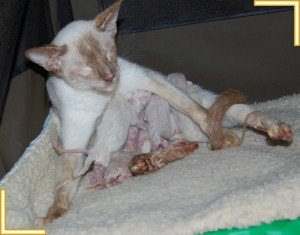 I thought it might be useful to include a couple of videos I made that show my Oriental cat giving birth to kittens. I know when I first started breeding I was very lucky as I had my mother on hand to actually show me how to help my cats when they are having kittens. Not everyone is as lucky so I thought I would add these videos as the next best thing.
I thought it might be useful to include a couple of videos I made that show my Oriental cat giving birth to kittens. I know when I first started breeding I was very lucky as I had my mother on hand to actually show me how to help my cats when they are having kittens. Not everyone is as lucky so I thought I would add these videos as the next best thing.
Don’t get me wrong in the vast majority of cases your cat will not need any help when the time arrives for the kittens to be born. However occasionally they will sometimes need assistance either from a vet or indeed in reviving kittens.
Being able to know when to go to the vet and when to wait is a difficult decision to make and nobody can make that call for you. So really if in doubt get on the phone to your vet and ask for advice. To be fair though most vets will ask you to fetch the girl into the surgery as of course it is almost impossible to make a diagnosis over the phone.
By watching the two videos you will see a birth that went well with no problems. You will witness what normal uterine contractions are and how they progress in intensity during the birthing process. You will also see how long it takes once the kitten is in the birth canal to actually being born.
Once the kitten has been born you will see in the second video how to quickly revive a kitten or if the kitten is already awake how to make sure the airways are clear. You will also witness my preferred method of detaching the umbilical cord quickly and with little blood loss.
The final portion of the video also shows the kitten taking his first feed and hopefully you will see what is meant when breeders use the term ‘latched on’. Latched on refers to when a kitten has the nipple in their mouths and their tongue curled around the nipple. They then begin to suckle and usually use their fronts paws to knead (some breeders use the term ‘on the pumps’). You will see in later life a cat will knead when they are happy and I believe this stems from when they suckled as a baby.
So hopefully you will learn something from watching the videos of my cat giving birth and also the kitten being revived. If you have any questions then please feel free to contact me or use the comments section at the foot of the page if their is something I have not covered.
Check out the video below.
Added – 11/10/2012 –
Dear Ross,
My tonkinese queen has about 10 days to go from my estimate before she has her kitten/s. Her belly is enormous although she is extremely small and slight (being only 16 months old herself). I am not a breeder so I can’t recall any instruction about birthing kittens since my childhood (a fair time ago now). I only have two questions which I would like to ask you from Australia (as your videos were amazing! Riveting even!):
- I am concerned that if I help my queen birth or clean her kittens the way you show in your video, she will “reject” her kitten/s as they smell of me rather than her. Is there anyway I can help her without this risk? Or if my queen loves me (which she does!), she won’t mind my assistance? What environment will a queen prefer to birth in?
- What are “danger signs” that things are not going well? When should I call the vet?
- How long is a standard tonkinese labour?
Thanks for any assistance. I would like to be prepared to help her have a safe and happy birthing.
Kind regards
Diana
Below is my reply –
Hi Diana
I am pleased you enjoyed the video and you found it useful.
- If you help your queen and clean the kittens up, clear airways and revive them you should have no problems at all with your girl accepting them. I would put this concern out of your mind completely.
- Danger signs are varied but the main one to watch for is your girl being unable to part with kittens naturally. If she is pushing very hard for over two hours without a kitten then seek veterinary help asap. When I say pushing hard I mean in the way I describe in the video, not just contractions I mean when you see the uterus bulging out and the girl straining.
- Tonkinese labour is the same as any other cat. There is no set time but in my experience it can be from a few hours to all day.
One last thing, the majority of cats do not need help. They are actually capable of having the babies completely on their own. Try not to worry too much 9 times out of 10 the whole thing goes well.
Good luck,
Ross

